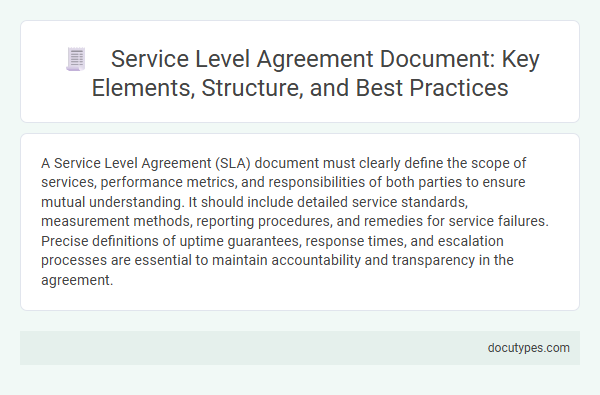A Service Level Agreement (SLA) document must clearly define the scope of services, performance metrics, and responsibilities of both parties to ensure mutual understanding. It should include detailed service standards, measurement methods, reporting procedures, and remedies for service failures. Precise definitions of uptime guarantees, response times, and escalation processes are essential to maintain accountability and transparency in the agreement.
Introduction to Service Level Agreements (SLAs)
What is a Service Level Agreement (SLA) and why is it important in business? A Service Level Agreement defines the expected level of service between a provider and a client, ensuring clear communication and accountability. Your SLA acts as a foundational document that outlines responsibilities, performance metrics, and remedies.
How does an SLA help manage expectations between parties? By specifying key elements such as service scope, performance standards, and reporting procedures, an SLA creates a transparent framework. This clarity reduces misunderstandings and fosters trust in the service relationship.
Importance of SLAs in Business Relationships
Service Level Agreements (SLAs) establish clear expectations between service providers and clients, defining measurable performance standards. These agreements help prevent disputes by outlining responsibilities and deliverables explicitly.
SLAs are vital for maintaining trust and accountability in business relationships, ensuring consistent service quality. They provide a framework for monitoring performance and managing penalties or remedies if standards are not met.
Core Components of an SLA Document
| Core Component | Description |
|---|---|
| Service Description | Defines the specific services provided, including scope, features, and limitations. |
| Performance Metrics | Details measurable criteria such as uptime, response time, and throughput to evaluate service quality. |
| Responsibilities | Outlines obligations of both the service provider and the client to maintain service standards. |
| Problem Management | Specifies procedures for reporting, managing, and resolving service issues or incidents. |
| Penalties and Remedies | Describes compensation or corrective actions if agreed levels are not met. |
| Reporting and Monitoring | Defines how service performance will be tracked, reported, and communicated to stakeholders. |
| Duration and Review | States the agreement's validity period, renewal terms, and processes for periodic review or amendment. |
| Security and Confidentiality | Addresses data protection, privacy requirements, and confidentiality obligations associated with the service. |
| Dispute Resolution | Specifies the methods and steps for resolving conflicts related to the service delivery or agreement terms. |
Defining Service Scope and Objectives
Defining service scope and objectives is a fundamental element in a Service Level Agreement (SLA) document. It clearly outlines the specific services to be delivered and the boundaries within which these services will operate.
Establishing precise objectives ensures both parties have a mutual understanding of expected performance and outcomes. This clarity minimizes disputes and aligns service delivery with business goals.
Performance Metrics and Measurement Criteria
Performance metrics and measurement criteria form the backbone of a Service Level Agreement document, defining the standards for service delivery and success. Clear, quantifiable indicators ensure accountability and enable objective evaluation of service quality.
- Defined Performance Indicators - Specific metrics such as response time, uptime percentage, and resolution time establish measurable service expectations.
- Measurement Methods - The tools and techniques used for tracking service levels, like automated monitoring systems or manual reporting, provide transparent data collection.
- Thresholds and Targets - Predefined performance thresholds and target values set the minimum acceptable standards and goals for service quality.
Roles and Responsibilities of Parties
Roles and responsibilities in a Service Level Agreement (SLA) clearly define the duties of each party involved, ensuring accountability and transparency throughout the service delivery process. The service provider is responsible for meeting specified performance standards, while the client must outline service requirements and provide necessary support. Defining these roles prevents misunderstandings, facilitates effective communication, and supports compliance management within the SLA framework.
Reporting, Monitoring, and Review Mechanisms
Service Level Agreements (SLAs) require clear specifications on reporting, monitoring, and review mechanisms to ensure service quality and accountability. These components define how performance data is collected, assessed, and communicated between parties.
- Reporting Frequency - Establishes how often performance reports are generated to track service delivery against agreed standards.
- Monitoring Tools - Details the technologies and processes used to continuously observe service performance and detect issues in real time.
- Review Procedures - Outlines scheduled evaluations and meetings to assess SLA compliance, address discrepancies, and implement improvements.
Penalties, Remedies, and Escalation Procedures
Service Level Agreements (SLAs) must clearly define penalties, remedies, and escalation procedures to ensure accountability and effective dispute resolution. These elements protect both parties by specifying consequences and steps for unresolved issues.
- Penalties - Outline financial or service credits imposed when performance standards are not met.
- Remedies - Describe actions available to the client to address service deficiencies or breaches.
- Escalation Procedures - Establish a clear process for raising and resolving issues that remain unresolved at lower levels of communication.
Your SLA should explicitly state these components to maintain transparency and enforce service commitments.
Best Practices for Effective SLA Creation
A Service Level Agreement (SLA) must clearly define the scope of services, performance metrics, and responsibilities of both parties to ensure mutual understanding and accountability. Precise definitions prevent ambiguities and help maintain consistent service delivery.
Best practices for effective SLA creation include setting measurable and realistic performance targets, outlining penalties for non-compliance, and establishing transparent communication channels. It is essential to involve all stakeholders during the drafting process to align expectations. Regular reviews and updates keep the SLA relevant and responsive to changing business needs.
What Are the Key Elements Needed in a Service Level Agreement Document? Infographic

